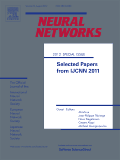
Frontiers in Computational Neuroscience
Scope & Guideline
Unlocking the Mysteries of the Brain through Computational Insight.
Introduction
Aims and Scopes
- Computational Modeling of Neural Dynamics:
The journal focuses on various computational models that simulate neural dynamics, including spiking neural networks, neural mass models, and other mathematical frameworks that help in understanding brain functions and disorders. - Machine Learning and Artificial Intelligence Applications:
There is a strong emphasis on the application of machine learning and AI techniques in neuroscience, particularly in areas like neuroimaging, EEG analysis, and diagnostic applications for neurological disorders. - Neurobiological Insights and Mechanisms:
Research published in the journal often delves into the biological underpinnings of neural processes, investigating the interactions at the cellular and network levels that contribute to cognitive functions and behaviors. - Interdisciplinary Approaches to Neuroscience:
The journal encourages interdisciplinary research that merges insights from neuroscience, psychology, computer science, and engineering to address complex problems in understanding brain function and dysfunction. - Neuroinformatics and Data Analysis:
Frontiers in Computational Neuroscience publishes studies that develop new methods for analyzing neural data, focusing on big data approaches, neuroinformatics, and the integration of multimodal datasets.
Trending and Emerging
- Deep Learning Applications in Neuroimaging:
There is a significant increase in research utilizing deep learning techniques for neuroimaging analysis, particularly in detecting and classifying neurological disorders from MRI and EEG data. - Neurocomputational Models for Neurological Disorders:
Emerging studies focus on developing neurocomputational models that simulate the pathophysiology of neurological disorders, enhancing understanding and offering insights for therapeutic interventions. - Integration of AI and Neuroscience:
The intersection of artificial intelligence and neuroscience is becoming increasingly prominent, with research exploring how AI methodologies can inform and improve neurological research and applications. - Multiscale and Multimodal Approaches:
A trend towards incorporating multiscale and multimodal approaches in studies is evident, reflecting a holistic view of brain function that accommodates data from various levels of analysis. - Cognitive Neuroscience and Computational Psychiatry:
There is a growing interest in cognitive neuroscience applications within computational psychiatry, focusing on how computational models can elucidate cognitive processes and psychiatric disorders.
Declining or Waning
- Basic Theoretical Neuroscience:
There has been a noticeable decline in purely theoretical models that do not incorporate experimental validation or practical applications, indicating a shift towards more applied research. - Single-Method Studies:
Papers focusing solely on a single methodology, such as traditional statistical analyses without computational enhancement, are becoming less frequent as the field increasingly favors integrated approaches that combine multiple methodologies. - Neurophilosophy and Conceptual Discussions:
Discussions centered on neurophilosophical implications or theoretical frameworks lacking empirical support are waning, as the journal leans more towards empirical studies with clear computational or experimental outcomes.
Similar Journals

CEREBRAL CORTEX
Pioneering research in cognitive and molecular neuroscience.CEREBRAL CORTEX, published by Oxford University Press Inc, is a premier journal dedicated to advancing the field of neuroscience, specifically focusing on the cellular, molecular, and cognitive aspects of cortical structure and function. With an impressive impact factor that situates it in the top quartile (Q1) of its categories for 2023, this journal holds significant relevance for researchers and professionals interested in the latest discoveries and methodologies in both Cognitive Neuroscience (ranked #31 out of 115) and Cellular and Molecular Neuroscience (ranked #48 out of 97). Operating without an open access model, it ensures rigorous peer review and dissemination of high-quality research from across the globe. Since its inception in 1991, CEREBRAL CORTEX has established itself as a critical platform for educators and inventors, pushing the boundaries of knowledge in understanding brain function and its implications for behavior. Researchers and students alike will find this journal an invaluable resource for both foundational and cutting-edge studies in neuroscience.

NEURAL NETWORKS
Advancing Knowledge in Neural InnovationsNEURAL NETWORKS, an esteemed journal with the ISSN 0893-6080 and E-ISSN 1879-2782, is published by Pergamon-Elsevier Science Ltd in the United Kingdom. This influential journal, established in 1988 and continuing its publication through 2024, is recognized for its significant contributions to the fields of Artificial Intelligence and Cognitive Neuroscience, ranking in the Q1 category in both disciplines as of 2023. With a strong Scopus rank of #4/115 in Cognitive Neuroscience and #35/350 in Artificial Intelligence, and a commendable percentile of 96th and 90th respectively, NEURAL NETWORKS stands at the forefront of academic research. Researchers, professionals, and students can benefit from the journal's rigorous peer-review process and the dissemination of groundbreaking findings that shape understanding in artificial intelligence methodologies and their cognitive applications. While the journal currently operates under traditional access options, it serves as a vital resource in fostering innovations and cross-disciplinary collaboration.

BIOLOGICAL CYBERNETICS
Pioneering Research in Biological CyberneticsBIOLOGICAL CYBERNETICS is a premier journal published by SPRINGER, dedicated to advancing the fields of biotechnology and computer science through the lens of biological interactions. With an ISSN of 0340-1200 and an E-ISSN of 1432-0770, this esteemed journal has been a cornerstone of academic research since its inception in 1961 and is set to continue influencing the landscape of biological cybernetics through 2024. The journal currently holds a Q3 ranking in the Biotechnology category and a Q2 ranking in miscellaneous Computer Science according to the 2023 category quartiles, showcasing its credibility and impact in the interdisciplinary nexus of these fields. Although it does not provide open access options, researchers and students can engage with its innovative content that includes original research articles, reviews, and methodologies that explore the computational modeling of biological systems and the integration of artificial intelligence in biological research. With its strategic location in the United States and a robust publication record, BIOLOGICAL CYBERNETICS remains an essential resource for anyone looking to deepen their understanding and application of cybernetic principles within biological contexts.

JOURNAL OF NEUROSCIENCE METHODS
Pioneering Methodological Advances in NeuroscienceWelcome to the JOURNAL OF NEUROSCIENCE METHODS, a prestigious platform for disseminating innovative methodologies in the interdisciplinary field of neuroscience. Published by Elsevier, this journal has been pivotal since its inception in 1979, covering a diverse range of experimental techniques and methods aimed at advancing our understanding of neural systems and functions. With a commendable impact factor and classified within the Q2 category in Neuroscience (miscellaneous) as of 2023, the journal continues to attract high-quality research from professionals, scholars, and students alike. While maintaining a robust subscription model, it provides unparalleled access to groundbreaking studies, fostering collaboration and knowledge exchange among the global neuroscience community. Join us as we explore and contribute to the evolution of neuroscience methodologies through rigorous research and comprehensive reviews, setting the stage for future discoveries.

Brain Communications
Advancing Neuroscience Through Open DialogueBrain Communications is an esteemed, open-access academic journal published by Oxford University Press since 2019, focusing on the dynamic field of neuroscience. With a dedicated ISSN and an E-ISSN of 2632-1297, this journal aims to address the intricate relationships between brain functions, psychiatric disorders, and neurobiological mechanisms. The journal stands out in the academic realm, holding a prestigious Q1 ranking across several categories, including Biological Psychiatry, Cellular and Molecular Neuroscience, Neurology, and Psychiatry and Mental Health for 2023. Notably, it has also secured impressive Scopus ranks in various neuroscience and psychiatry fields, evidencing its commitment to high-quality research. With an impact factor reflective of its growing influence, Brain Communications provides accessible research findings to professionals, researchers, and students alike, fostering a deeper understanding of complex neurological phenomena. This innovative journal is pivotal for anyone involved in advancing knowledge in neuroscience and mental health.

Frontiers in Systems Neuroscience
Pioneering research in the realm of neuroscience.Frontiers in Systems Neuroscience is a premier open-access journal published by FRONTIERS MEDIA SA, dedicated to advancing the understanding of the complex systems that underpin neural function and behavior. Established in 2007 and based in Switzerland, this journal has gained recognition for its rigorous peer-reviewed articles that contribute significantly to the fields of Cellular and Molecular Neuroscience, Cognitive Neuroscience, and Developmental Neuroscience. As of 2023, it proudly holds a Q2 ranking in several neuroscience categories, reflecting its high impact and relevance in the academic community. The journal is accessible to researchers, professionals, and students worldwide, providing a platform for innovative research while promoting collaborative scientific dialogue. With a commitment to open access, Frontiers in Systems Neuroscience ensures that groundbreaking findings are readily available to enhance knowledge sharing across the globe. This makes it an essential resource for anyone looking to stay at the forefront of neuroscience research.

Journal of Advanced Computational Intelligence and Intelligent Informatics
Fostering Collaboration in Advanced Computational IntelligenceThe Journal of Advanced Computational Intelligence and Intelligent Informatics, published by FUJI TECHNOLOGY PRESS LTD, stands as a pivotal platform in the fields of Artificial Intelligence, Computer Vision, and Human-Computer Interaction. Established in 1997, this Open Access journal has been providing accessible insights into the latest advancements in computational intelligence and informatics since 2007. With its ISSN 1343-0130 and E-ISSN 1883-8014, this journal invites a diverse readership, including researchers, professionals, and students eager to explore innovative methodologies and applications. Despite its current Q4 ranking in the relevant categories, the journal remains committed to contributing valuable knowledge to the academic community and enhancing the global discourse in computational technologies. With its focus on fostering communication and collaboration among scholars, the journal plays an essential role in driving forward the understanding of intelligent systems and their applications in various domains.

Natural Computing
Innovating Through Nature's Computational WisdomNatural Computing is a leading peer-reviewed journal published by Springer, focusing on the interdisciplinary study of natural computation methods and their applications across various domains. With an ISSN of 1567-7818 and an E-ISSN of 1572-9796, this journal has established itself as vital in the field of Computer Science Applications, as reflected in its esteemed Q2 quartile ranking and a Scopus rank of #358 among 817 journals, placing it in the 56th percentile. Based in the Netherlands, Natural Computing covers a diverse range of topics, including computational models inspired by natural systems, evolutionary algorithms, and swarm intelligence. Seeking to bridge the gap between theoretical research and practical applications, this journal serves researchers, professionals, and students by providing insights and advancements in the field. With a commitment to fostering innovation, Natural Computing aims to push the boundaries of understanding in computational methods inspired by nature, making it an essential resource for those looking to contribute to and stay updated within this dynamic area.

PLoS Computational Biology
Connecting Minds in Computational BiologyPLoS Computational Biology is a premier open-access journal published by the Public Library of Science, committed to advancing the understanding of complex biological data through computational approaches. Since its inception in 2005, the journal has made significant strides in the fields of Cellular and Molecular Neuroscience, Computational Theory and Mathematics, Ecology, Genetics, and Molecular Biology, achieving a notable Q1 ranking in various categories as of 2023. With an exceptional impact factor and an esteemed ranking—such as Rank #23/176 in Computational Theory and Mathematics—PLoS Computational Biology provides a vital platform for researchers, professionals, and students to disseminate their cutting-edge findings and insights. The journal's open-access model ensures that high-quality research is freely accessible worldwide, fostering collaboration and innovation across disciplines. Located in San Francisco, CA, it serves as a hub for the global scientific community, making it an indispensable resource for anyone at the forefront of computational biology and its diverse applications.

THEORETICAL AND COMPUTATIONAL FLUID DYNAMICS
Pioneering Computational Techniques for Fluid Dynamics.THEORETICAL AND COMPUTATIONAL FLUID DYNAMICS, published by SPRINGER, stands at the forefront of scientific discourse in the fields of fluid mechanics and computational methods. With an impressive impact factor reflecting its significance and reach, this journal has consistently maintained a Q1 ranking across multiple categories, including Computational Mechanics and Condensed Matter Physics as of 2023. Covering a rich scope of theoretical research and computational analysis, it aims to advance the understanding of fluid flow and transfer processes, making it an essential resource for researchers, professionals, and students alike. The journal, with its historical archive extending from 1989 to 2024, not only contributes to foundational theories but also integrates applied research and emerging computational techniques, thus facilitating innovation within the discipline. As a result, THEORETICAL AND COMPUTATIONAL FLUID DYNAMICS serves as a crucial platform for disseminating impactful findings that shape future advancements in fluid dynamics research.